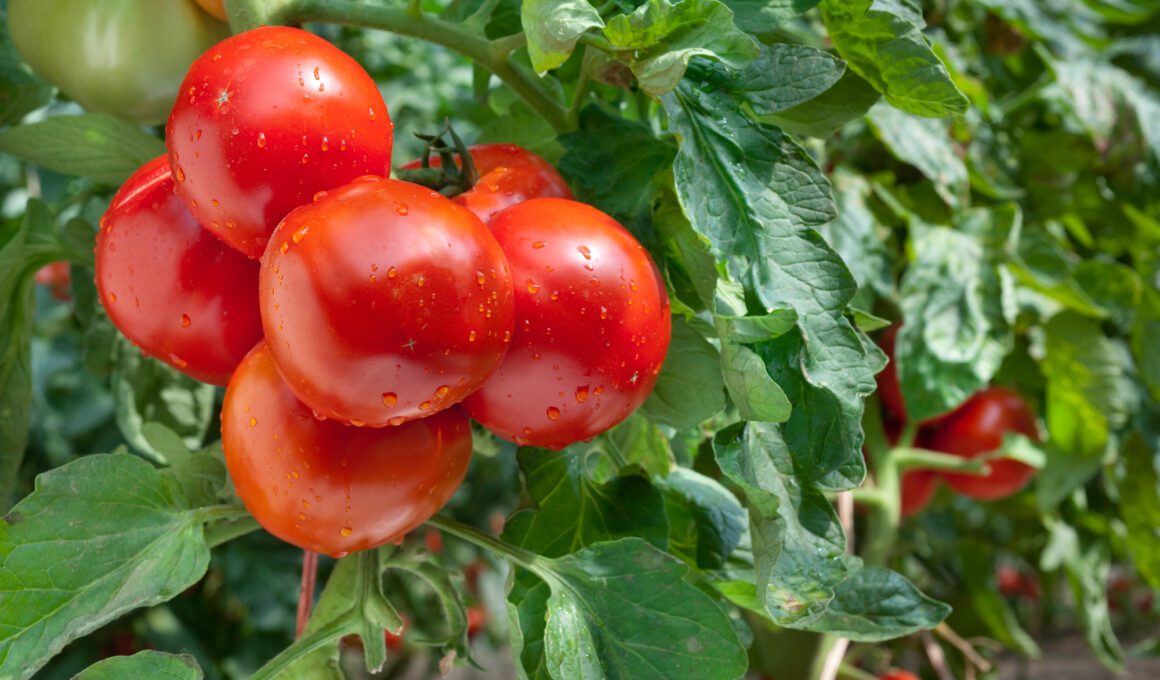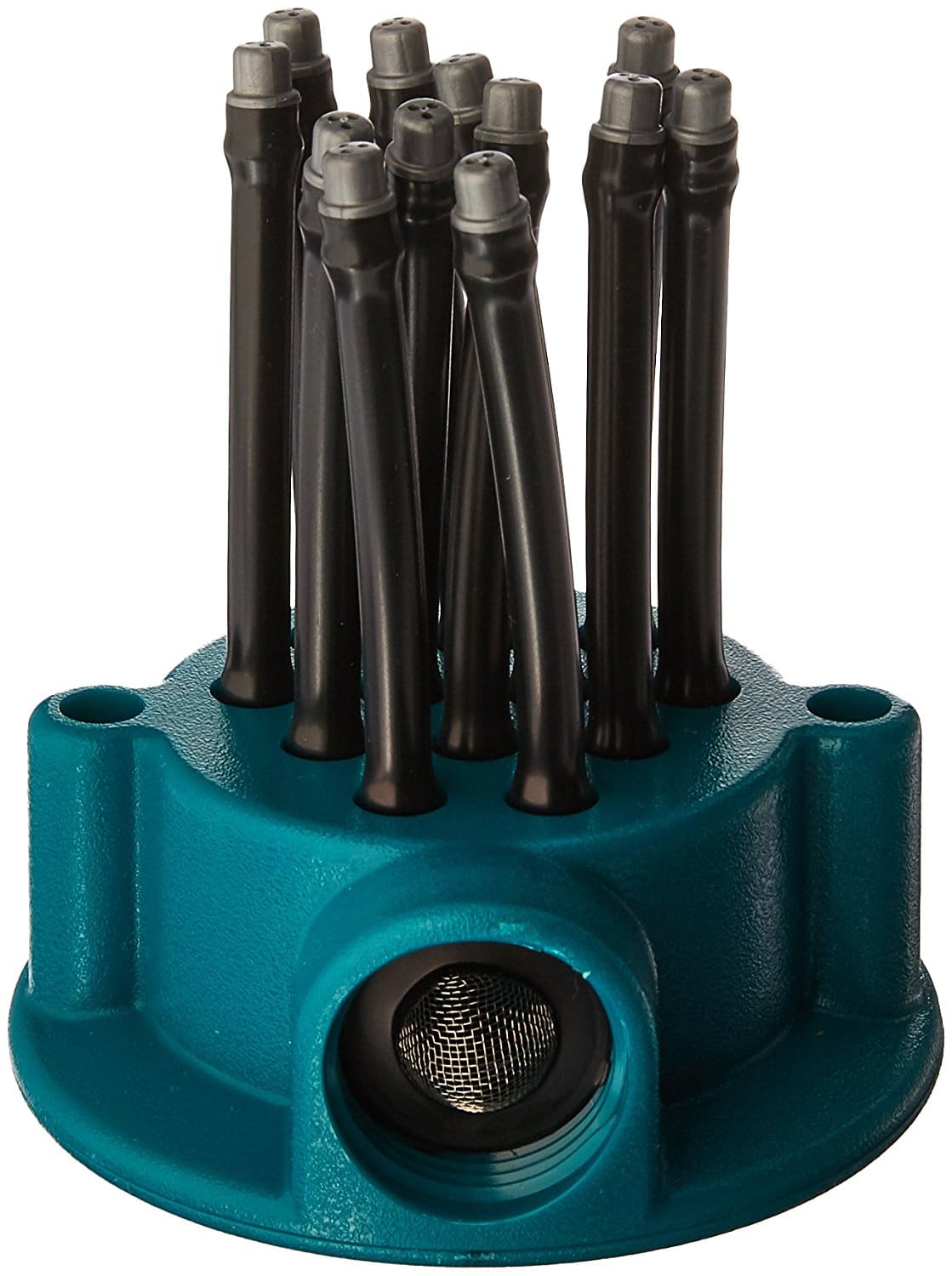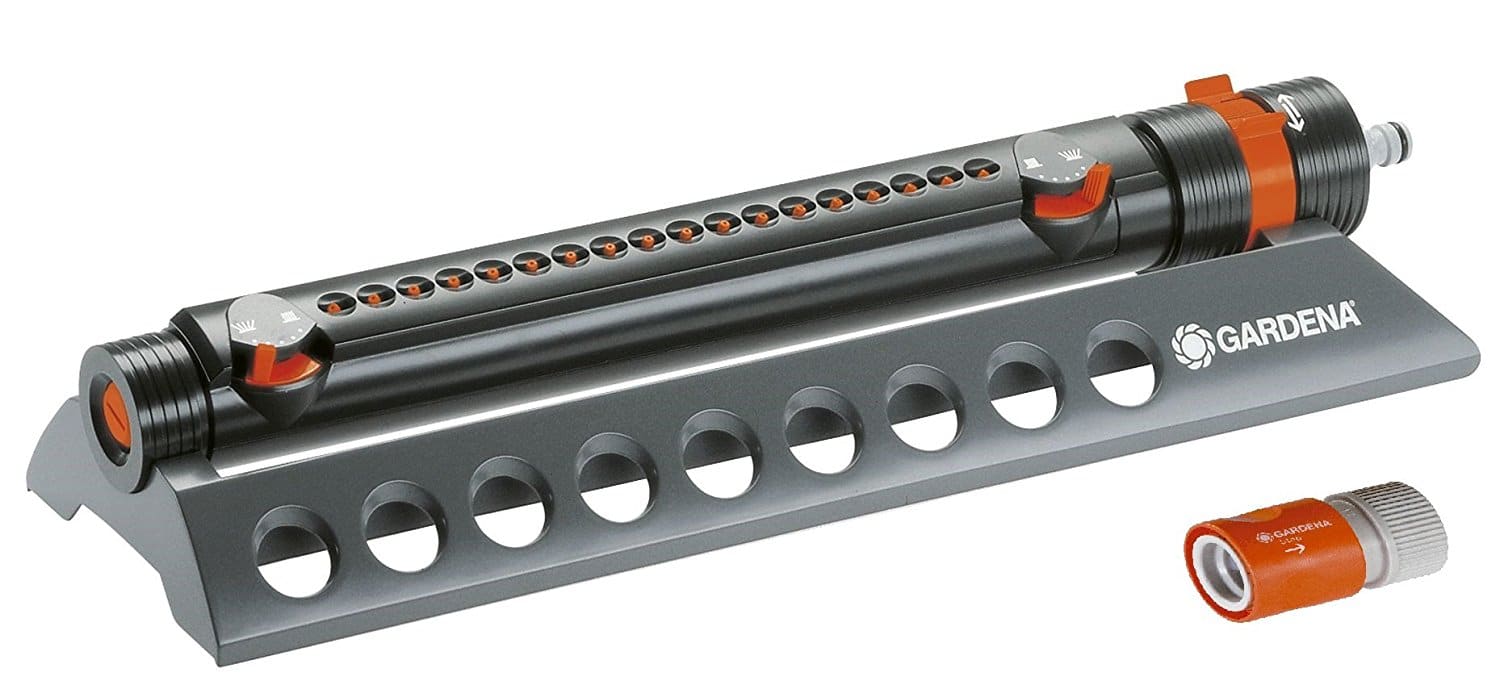Tomato plants are known for their love of Epsom salt, but you might be wondering, can you put too much Epsom salt on tomato plants?
The short answer is yes, it’s possible to overdo it with Epsom salt, leading to potential problems for your tomatoes. Epsom salt is rich in magnesium, which is an essential nutrient for healthy plant growth. While beneficial in the right amount, too much of a good thing can harm your plants.
Applying excessive Epsom salt to your tomatoes can cause a buildup of salts in the soil, which can harm your plants by reducing their ability to absorb water and nutrients. In severe cases, this can lead to wilting, yellowing leaves, and stunted growth. Therefore, it’s crucial to be mindful of how much Epsom salt you’re using and to follow recommended guidelines to avoid any adverse effects.
To keep your tomato plants in top condition, apply Epsom salt sparingly and only when necessary, typically around 1 tablespoon per gallon of water every four to six weeks. Always monitor your plants’ response and adjust the application accordingly. When used in moderation, Epsom salt can promote healthy, productive tomato plants.
Understanding Epsom Salt and Its Benefits
Epsom salt, or magnesium sulfate, isn’t your ordinary table salt. In fact, it’s quite different and offers numerous benefits for your tomato plants. Before diving into whether you can put too much Epsom salt on your tomatoes, let’s take a closer look at what it is and its advantages.
Epsom salt is a natural mineral compound that contains magnesium and sulfur, both of which are essential for plant growth. Magnesium helps in the development of strong roots and the production of chlorophyll, while sulfur aids in the formation of amino acids, proteins, and enzymes. So, how does this translate to perks for your tomatoes?
Boosting magnesium levels with Epsom salt can lead to:
- Better fruit production: Magnesium encourages more blossoms and consequently, higher yields.
- Improved flavor: Adequate magnesium, aided by Epsom salt, contributes to sweeter, tastier tomatoes.
- Increased nutrient absorption: Magnesium strengthens cell walls, allowing for better uptake of vital nutrients.
Sulfur, on the other hand, contributes to:
- Disease resistance: Sulfur is known to strengthen plants and reduce their vulnerability to common tomato diseases like blight and fungal infections.
- Enhanced photosynthesis: The presence of sulfur supports the production of chlorophyll, resulting in more efficient photosynthesis.
However, it’s crucial to know when and how much Epsom salt your tomato plants need. Excess magnesium and sulfur could lead to the risk of an imbalance in other essential nutrients. Applying the right amount at the appropriate time can save your plants from potential damage.
For optimal benefits, experts typically recommend the following application rates for Epsom salt:
| Growth Stage | Application Rate |
|---|---|
| Seedlings | 1 tablespoon/gallon of water |
| Transplanting | 1 cup/100 square feet of soil |
| Flowering | 1 tablespoon/gallon of water, applied every 2 weeks |
By understanding the benefits of Epsom salt and its proper application, you’ll be able to make informed decisions on whether it’s the right choice for your precious tomatoes. Remember to always monitor your plants’ health and adjust your gardening practices accordingly for the best results.
How Epsom Salt Affects Tomato Plants
You might be wondering how Epsom salt benefits your tomato plants. Epsom salt, or magnesium sulfate, is a natural mineral compound that provides essential nutrients to your plants. Magnesium is vital for photosynthesis, while sulfur helps in the synthesis of some plant proteins. Here’s how these elements benefit your tomato plants:
- Magnesium plays a crucial role in your tomato plants’ photosynthesis process. It helps in the formation of chlorophyll, which is essential for capturing sunlight and converting it into energy. When there’s a magnesium deficiency, your plants’ leaves may turn yellow or develop interveinal chlorosis, causing them to struggle with photosynthesis and growth.
- Sulfur, on the other hand, is a vital nutrient for overall plant health. It’s required for the formation of essential amino acids and proteins, and it ensures your plants produce healthy and flavorful fruit.
Using Epsom salt in moderate amounts has its advantages, and some gardeners claim that it leads to:
- Increased fruit production, as the additional magnesium helps produce more flowers and fruit.
- Improved taste and color of tomatoes, as the boosted nutrient content results in better quality produce.
- Healthier foliage, with stronger stems and fewer incidences of leaf curl or yellowing.
However, it’s essential to remember that too much Epsom salt can cause harm. High concentrations of magnesium and sulfate can lead to a nutrient imbalance in the soil. This affects your plants through:
- Nutrient lockout: Excess magnesium in the soil can lead to the unavailability of other crucial nutrients, like calcium and potassium. This may result in nutrient deficiencies, affecting plant health.
- Reduced plant growth: Overuse of Epsom salt can cause stunted or slowed growth, as the nutrient imbalance affects plant development.
So, it’s essential to apply Epsom salt sparingly. To avoid causing harm, follow these guidelines:
- Use Epsom salt only when you’ve identified a magnesium deficiency or have tested your soil and concluded that extra magnesium is needed.
- Follow the recommended application rates, typically around 1 tablespoon per gallon of water for a foliar spray or 2 tablespoons per plant when side-dressing.
By using Epsom salt cautiously, you’ll find that it can indeed be helpful in your quest for flourishing tomato plants. Just remember not to overdo it – sometimes, less is more.
Common Signs of Epsom Salt Deficiency
When growing tomato plants, it’s essential to maintain the right balance of nutrients for optimal growth. One of these nutrients, Epsom salt (magnesium sulfate), plays a crucial role in several plant processes. If your tomato plants aren’t getting enough Epsom salt, they might show specific symptoms that signal a deficiency. Here are some common signs to look out for:
- Interveinal chlorosis: A noticeable symptom of Epsom salt deficiency is the yellowing of leaves between their veins. This discoloration starts at the leaves’ edges and progresses towards the center. The veins themselves remain green, resulting in a contrasting appearance between the veins and the rest of the leaf surface.
- Leaf curling: Magnesium deficiency can cause tomato leaves to curl upward and become stunted or misshapen. If you notice this happening with your plants, it might be a sign that they need more Epsom salt.
- Blossom end rot: Although more commonly associated with calcium deficiency, blossom end rot can also occur due to insufficient Epsom salt. This condition affects the bottom end (blossom end) of the fruit, causing it to darken and decay. It’s essential to address this issue quickly to prevent further damage to your crops.
- Reduced flowering and fruit production: Epsom salt plays a vital role in helping plants produce flowers and fruits. When there’s a deficiency, you may notice a significant reduction in the number of flowers and fruits your tomato plants produce.
- Premature fruit drop: If your tomato plants have an Epsom salt deficiency, they may drop their fruits before they’ve reached full maturity. This can lead to a reduced yield and lower overall crop quality.
To help you better understand these symptoms, take a look at this table that outlines the common signs of Epsom salt deficiency in tomato plants:
| Symptom | Description |
|---|---|
| Interveinal chlorosis | Yellowing of leaves between green veins |
| Leaf curling | Upward curling and misshapen leaves |
| Blossom end rot | Darkened, decaying fruit on the blossom end |
| Reduced flowering | Fewer flowers and fruits than expected |
| Premature fruit drop | Early dropping of fruits before they reach full maturity |
If you observe any of these symptoms on your tomato plants, it’s essential to take action and address the issue promptly. Thankfully, this is often as simple as adding an appropriate amount of Epsom salt to your plants’ soil or watering regimen. Remember, finding the right balance is critical – too much Epsom salt can also harm your plants. As a gardener, you’ll want to keep a close eye on your tomato plants’ health and provide the proper nutrients to ensure they thrive and produce a bountiful harvest.
The Right Way to Apply Epsom Salt
Applying Epsom salt to your tomato plants can have numerous benefits, but it’s essential to use the correct method and amount. Too much Epsom salt may cause harm to your plants or reduce its effectiveness. Here’s how to apply Epsom salt to your tomato plants the right way.
Timing is crucial. It’s important to apply Epsom salt during specific growth stages to provide the most benefits. The best times to use Epsom salt on your tomatoes are:
- During transplanting: When you first move your tomato seedlings to your garden, add Epsom salt to the planting hole.
- At mid-season: When your tomato plants start developing blossoms and fruit sets, apply Epsom salt to support growth and promote a higher yield.
Measuring the appropriate amount is essential to prevent issues from overuse. The recommended dosage for Epsom salt on tomato plants is:
- For soil application: Use 1 tablespoon of Epsom salt per foot of plant height. Dissolve the Epsom salt in two gallons of water and evenly distribute this solution to the soil around the base of the plant.
- For a foliar spray: Mix 1 tablespoon Epsom salt in a gallon of water, and spray directly onto the plant leaves.
Always be cautious when using Epsom salt and ensure you do not use more than the recommended amount to avoid upset the mineral balance or cause stress in the plants.
There are a few methods to apply Epsom salt to your tomato plants:
- Soil application: Applying Epsom salt directly to the soil allows the plant roots to absorb the nutrients more efficiently. This technique can be done by mixing the Epsom salt solution and pouring it around the base of the plant.
- Foliar spray: Spraying a dilution of Epsom salt directly onto the plant’s leaves allows for quick absorption of magnesium. This method is beneficial for addressing magnesium deficiencies or supporting overall plant health.
To sum it up, the right way to apply Epsom salt to your tomato plants involves timely application, carefully measuring the dosage, and selecting the most suitable application method. By following these guidelines, you’ll ensure your tomato plants benefit from the magnesium and sulfur in Epsom salt, promoting healthier growth and a more bountiful harvest.
Risks of Overusing Epsom Salt on Tomato Plants
While Epsom salt may be beneficial to your tomato plants in moderation, overusing it can lead to potential risks and damage. Using too much Epsom salt can cause a variety of problems for your tomato plants, which we’ll discuss in the following paragraphs.
One of the primary risks associated with excessive Epsom salt application is nutrient imbalance. Epsom salt contains magnesium sulfate, which can hinder the absorption of other essential nutrients such as calcium and potassium when the concentration is too high. This imbalance can lead to:
- Poor fruit development
- Stunted growth
- Vulnerability to diseases and pests
Moreover, overusing Epsom salt can result in salt buildup in your soil, which affects its overall health and fertility. High concentrations of salts may cause:
- Compaction of soil
- Reduced water infiltration
- Inhibition of beneficial soil organisms
To avoid these issues, it’s crucial to measure and apply the recommended dosage of Epsom salt for your tomato plants. Studies suggest that a well-balanced application of Epsom salt is approximately 1 tablespoon per gallon of water, applied once a month.
| Application Rate | Epsom Salt Amount | Water Amount |
|---|---|---|
| Well-balanced application | 1 tablespoon | 1 gallon |
However, it’s essential to consider your specific soil condition and requirements before adding Epsom salt. Since soils vary considerably, it’s wise to perform a soil test to determine the existing nutrient levels and adjust Epsom salt application accordingly.
To ensure optimal tomato plant health, consider these additional tips:
- Water your plants regularly, especially during dry spells, to prevent salt buildup in the soil.
- Apply organic matter, such as compost, to improve soil structure and nutrient availability.
- Rotate crops periodically to maintain a healthy soil environment and prevent nutrient depletion.
In summary, Epsom salt can be a valuable addition to your tomato plant care routine when used appropriately. However, it’s crucial to be cautious of the potential risks associated with overusing Epsom salt and focus on maintaining balanced soil nutrients and proper plant care practices.
Mitigating Damage from Excess Epsom Salt
If you’ve accidentally applied too much Epsom salt to your tomato plants, don’t panic! There are steps you can take to rectify the situation. By following these guidelines, you’ll help to mitigate the damage and bring your plants back to health.
Start by flushing the soil around your tomato plants with water. This helps dilute the concentration of Epsom salt in the soil, reducing the risk of further harm to your plants. Depending on the size of your plants and the excess amount applied, it might take several water applications to fully flush out the salts.
To monitor your plants’ progress, keep an eye on the foliage. If the leaves were yellowing or showing other signs of deficiency prior to the application of Epsom salt, they should begin to recover as the salt gets flushed out. Keep in mind that it may take some time for the full recovery of your plants, so be patient.
Balancing the soil nutrients is another essential step. Excessive Epsom salt can lead to an imbalance in the soil’s nutrient levels, so it’s important to have your soil tested to determine any deficiencies. Once you have the results, you can adjust the nutrients accordingly:
- If the soil is lacking in calcium, add gypsum or lime.
- In case of potassium deficiency, add potassium sulfate or another potassium-rich fertilizer.
- For a lack of magnesium, consider dolomite lime or a slow-release magnesium supplement.
Here’s a simple table to show the nutrients and their corresponding remedies:
| Nutrient | Remedy |
|---|---|
| Calcium | Gypsum or lime |
| Potassium | Potassium sulfate |
| Magnesium | Dolomite lime |
Lastly, consider adding organic matter to the soil, such as compost or aged manure. Organic material helps improve soil structure, promotes the growth of beneficial microorganisms, and provides additional nutrients to your plants. Improved soil structure can aid in the absorption of nutrients and help your tomato plants recover from excess Epsom salt exposure more quickly.
In summary, mitigating damage from excess Epsom salt involves flushing the soil, monitoring your plants’ progress, balancing soil nutrients, and incorporating organic matter. By taking these steps, you’ll help your tomato plants recover and thrive once again.
Alternative Ways to Boost Tomato Plant Health
While using Epsom salt has its benefits, it’s essential to explore alternative methods to enhance your tomato plants’ overall health. By incorporating these practices, you can ensure a bountiful and vibrant tomato harvest.
Optimal watering techniques play a pivotal role in tomato plant health. You should:
- Water your plants deeply and regularly; this helps their roots grow deeper and more robust.
- Avoid overhead watering, as wet foliage can lead to fungal infections.
- Use a soaker hose or drip irrigation to direct water to the root zone.
Proper fertilization is another critical aspect. Over or under-fertilizing can lead to several issues, including nutrient deficiencies and imbalances. To support your tomatoes:
- Use a balanced, all-purpose fertilizer, preferably organic, to provide essential nutrients.
- Apply compost or well-rotted manure to improve soil fertility and structure.
- Conduct a soil test to determine the necessary nutrients for your garden and adjust your fertilization plan accordingly.
Healthy soil is the foundation of a thriving garden. Soil amendments can significantly impact your tomato plants’ well-being:
- Incorporate organic matter, such as compost, aged manure, or leaf mold, to boost soil fertility.
- Consider adding specific amendments, like greensand or rock phosphate, to address specific nutrient deficiencies.
- Adjust your soil’s pH with lime (raise) or sulfur (lower) based on the results of a soil test. Tomatoes grow best in a slightly acidic soil (pH 6.0-6.8).
Practicing crop rotation and intercropping can help prevent disease build-up and reduce the risk of pests:
- Rotate tomatoes with non-nightshade family crops, such as beans, peas, or brassicas, to break disease and pest cycles.
- Plant companion plants, like basil, marigolds, or garlic, to repel pests and attract beneficial insects.
Regular pruning and staking can enhance airflow and light penetration, reducing the likelihood of diseases and improving overall plant vigor:
- Remove lower leaves and suckers to promote productive growth.
- Stake or cage plants to keep fruit off the ground and discourage fungal infections.
By implementing these alternative methods, you’ll set the stage for a successful tomato harvest and improve your plants’ overall health. Remember, a combination of proper care and attention to detail goes a long way in ensuring a thriving tomato garden.
Tips to Avoid Overuse of Epsom Salt
While Epsom salt can offer numerous benefits to your tomato plants, it’s essential to avoid overusing it. Too much Epsom salt can result in complications such as magnesium toxicity and nutrient imbalances. To ensure your plants remain healthy and flourishing, follow these crucial tips to avoid overusing this popular gardening additive.
1. Conduct a Soil Test
Before you apply any Epsom salt, it’s crucial to test your soil. By knowing the magnesium levels in your soil, you’ll be able to decide if Epsom salt is necessary and apply the appropriate amount. Soil tests are readily available at garden centers or through local agricultural extension services.
2. Use the Correct Dosage
Using the right amount of Epsom salt is essential to prevent overuse. Typically, the recommended dosage is 1 tablespoon per gallon of water. However, adjust the amount based on the results of your soil test. It’s vital to follow the recommended dosage to maintain balance and prevent potential harm to your tomato plants.
3. Apply Only When Necessary
Don’t fall into the trap of thinking that using Epsom salt frequently will lead to healthier plants. Instead, apply it only when required. Over-application can have adverse effects on your plants and the surrounding soil. Pay close attention to your plants’ growth and health, and only use Epsom salt when needed.
4. Consider Alternative Treatments
When you’re unsure about using Epsom salt, there are other alternative treatments for addressing nutrient imbalances or deficiencies. Examples of alternative treatments include:
- Using a balanced fertilizer
- Implementing organic methods, such as composting and soil amendments
- Employing mulching to maintain soil structure and improve nutrient availability
5. Monitor Your Plants
Lastly, always monitor your tomato plants for signs of over-fertilization, magnesium toxicity, or nutrient imbalances. Some indicators to watch for include:
- Yellowing or curling leaves
- Excessive growth with little flowering or fruit production
- Delayed fruit ripening
By being attentive to your tomato plants, you can swiftly address any issues and maintain their overall health.
By following these guidelines, you’ll be on your way to growing healthy and thriving tomato plants with just the right amount of Epsom salt. Remember, moderation is key, and it’s better to err on the side of caution when it comes to using any type of additive on your garden plants.
Frequently Asked Questions
Can you put too much Epsom salt on tomato plants?
Yes, overusing Epsom salt on tomato plants can harm them. Epsom salt contains magnesium sulfate, which is essential for photosynthesis and the production of chlorophyll. However, excessive amounts can lead to an imbalance of nutrients, causing nutrient lock-out and affecting the plants’ growth.
What are the recommended dosages of Epsom salt for tomato plants? The suggested dosage for Epsom salt application to tomato plants varies:
- Foliar spray: 1 tablespoon per gallon of water
- Soil application: 1 tablespoon per foot-height of the plant
- Transplanting seedlings: 1-2 tablespoons per hole Remember to always follow the label instructions on the Epsom salt packaging for accurate dosages.
What are the signs of Epsom salt overdose in tomato plants? When you’ve applied too much Epsom salt to your tomato plants, you might notice:
- Yellowing leaves
- Leaf curl
- Poor fruit production
- Wilting despite adequate watering
- Blossom end rot
What should I do if I’ve added too much Epsom salt to my tomato plants? If you suspect an overdose of Epsom salt, follow these steps to help your plants recover:
- Flush the soil with plenty of water to help dissolve and wash away the excess Epsom salt.
- Check and adjust the soil pH, as excessive Epsom salt might have altered it.
- Apply a balanced fertilizer according to the plant’s growth stage.
- Continue monitoring your plants for any signs of recovery or further issues.
Apart from Epsom salt, what other sources of magnesium can I use for my tomato plants? Alternative magnesium sources for tomato plants include:
- Dolomite lime (calcium magnesium carbonate)
- Magnesium sulfate (a less concentrated form of Epsom salt)
- Organic matter like compost and aged manure
Can I apply Epsom salt to other plants in my garden? Yes, you can use Epsom salt for other plants like peppers, roses, and even houseplants, but always do so in moderation. Each plant variety may have different requirements, so it’s important to research and follow the appropriate application rates based on the specific plant species.
Wrapping It Up: Striking the Right Balance
Maintaining the perfect balance for your tomato plants’ Epsom salt usage is crucial. To ensure your plants’ growth, it’s essential to consider several factors. Here’s a wrap-up of the essential points to remember.
Be mindful of the quantity and frequency of Epsom salt application. It’s generally recommended to:
- Use 1 tablespoon of Epsom salt per gallon of water for a foliar spray.
- Repeat this application every 4 to 6 weeks during the growing season.
Avoid using excessive amounts of Epsom salt, as this may lead to nutrient imbalances, reduced growth, and eventual plant failure. Keep a close eye on your plants, checking for any early signs of Epsom salt overuse:
- Stunted growth
- Leaf curling
- Chlorosis (yellowing leaves)
- Necrosis (dead tissue)
Practice good gardening habits, such as:
- Regularly testing and amending your soil
- Ensuring adequate drainage
- Applying appropriate fertilizers in addition to Epsom salt
Remember, Epsom salt is not a miracle solution to your tomato plants’ needs. It should be part of an integrated approach, compatible with a well-rounded nutrient regimen.
Ultimately, it’s crucial to monitor the condition of your tomato plants and adjust Epsom salt applications as needed. By striking the right balance, you’ll keep your plants thriving and produce that delicious, bountiful harvest.








